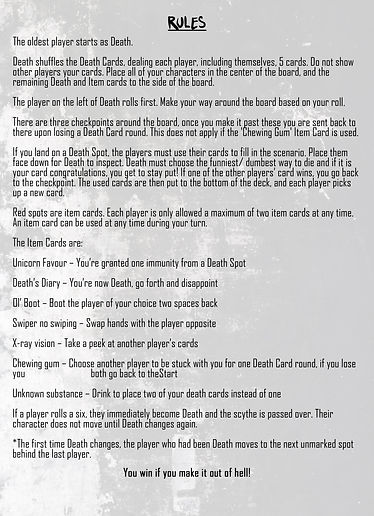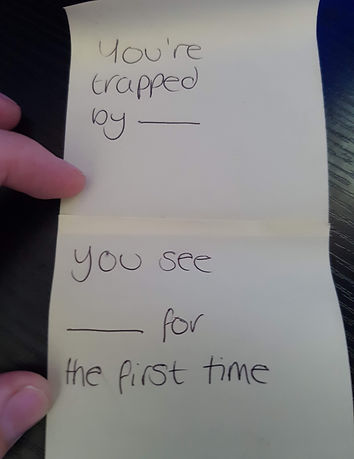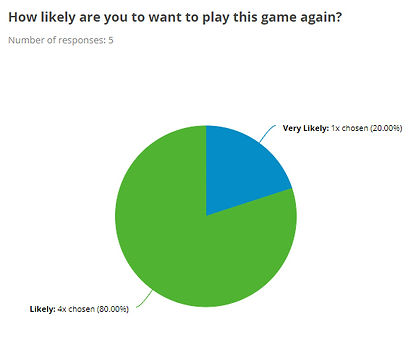EVALUATION
The project was to create a board game, in doing so we went through the process of concept, design, rules, playtests and implementing changes based on feedback.
The hardest problem is to take a step back and view the game with an unbiased perspective, in order to understand problems and admit to functions that do not work properly. My initial playtest was really helpful for me, because although I knew my game and how I wanted it to work, my friend didn't and was therefore able to see issues that I'd missed.
I don't personally enjoy board games that much, and the deepest I've really delved is Monopoly. However, one of my favourite games to play with my friends is Cards Against Humanity, so I thought that I could bridge the gap between board games with the insanity of CAH. To this end, I think that my game does the best it can to have the mechanic of Cards Against Humanity, while incorporating moving around a board. It also helps that there are other elements involved so, stupid deaths aside, it can still appeal to more traditional board game players.
When I first made my board, the mechanic was to have the Death player suggest a scenario, and the players give the stupidest way to die in that situation. This changed after a few playtests as people thought it would work better if player cards filled the suggestion and Death chose the best card.
I used Photoshop to design the board and cards as it is the software I am most familiar with. It allows me to manipulate photos, text and draw if I want to, and it is my preferred editing software. I had to consider where I got my stock images from, and this took me to a site called Pexels, which provided me with plenty of images to adapt into my designs. Stock website like this can be limited though, which is why I chose to draw certain parts myself.
The first playtest I did was very early in the development cycle. As soon as I had a physical version of my game, I invited a friend round to play it with me. I verbally described the rules and from there I let her play and work things out herself. Seeing how a player initially interacts with a game and reacts to the mechanics and places on the board helped me to adjust the rules when writing them and from there I also added in checkpoints. We both found that although playing on frustration, for many players the possibility of literally not getting past the inner circle would make the game impossible to win. It's hard to get the line between frustrating and fun right, and without this test it would have caused a lot of issues going further.
The other playtests were to refine the rules and how the game plays. This is where the issue of the mechanic arose. From there I changed the fundamentals of the game to what the players wanted. The people who played were within my target audience and I therefore found their feedback extremely valuable.
WHAT
Observations and Evaluations
WHEN
24/09/2018

This is a simplification of some of the verbal responses I received after people played my game and my own initial observations.
From this I can draw a few quick conclusions:
The rules need to be easier to read and simplified so as not to bog down players when they start to play.
People have mixed feelings on both the Death player mechanic and the scenario spots.
I have begun to think about what I would do to fix this problem. The rules are an easier fix, as it only requires a quick rewrite and possible format change.
However, changing the Death mechanic itself has the possibility of creating more problems than it fixes. In it's current state the game is playable, and the players all get to interact with the outcome of the game; from the roll, having an Item Card, being Death and deciding the scenario.
The first solution that was suggested to me by a player was to have the scenarios filled by the player's cards, and Death chooses the best one. This would require changing some of the scenarios on the board as well as rewriting the rules. This change would mean that the player who is Death has less interaction with the game and simply becomes a judge; I wanted them to be more involved and the freedom to choose any word makes the game more re-playable. The inspiration for my game comes from Cards Against Humanity and I fear that if I make the players fill scenarios with their cards and have Death choose the best, it becomes a CAH clone with a board.
In order to get a more accurate reflection on whether the mechanic I introduced works well or not, I would need to find a sample base that hasn't played CAH before. This would be difficult but it would allow me to see whether it's the preconceived notion that the scenario gaps should be filled by player cards, or if that is the best way for the game to be played. If it is the latter, then I would need to rethink the whole game in order to avoid plagiarism.
I could also mix the player filled scenarios with the Death suggested scenarios around the board, however this would be difficult to word in the rules and would likely only confuse players further.
WHAT
Second Playtest
WHEN
24/09/2018




This was the first real playtest with the final rules and everything else in place. It was interesting to see an unbiased group of people look at my game for the first time. As with my first playtest, the progression of the game was evidence that the game functioned, and was in the very least playable. Players laughed at certain cards and enjoyed being Death when it meant you sent someone back to the beginning.
I think that being Death lost it's novelty for these players rather quickly as one player remained death for several goes. This does test the minimum player suggestion, and I may need to change it to four; in a large group of players Death changed more rapidly and people therefore don't feel stuck.
The repetitive scenario situation could be solved by having a maximum of five rounds in the middle of the board. I'm not going to implement this however as it ruins the point of the game being frustrating, but it is something to keep in mind if future surveys show the same sort of responses.
FIXES BEFORE THE FINAL PLAYTEST:
-
Simplify the rules
-
Adjust the mechanic so that players fill in the scenarios with their Death Cards
-
Change the scenario spots that don't fit the new mechanic
-
Add more Item Cards
WHAT
Evaluation Of Final Playtest
WHEN
27/09/2018

I changed the font for the rules to make them easier to read. I've made it so that players fill the scenarios with their cards and Death chooses the best one.
The rest of the rules remain the same because they still work even with the changed Death mechanic.
People liked the references and stupid ways to die, so I don't need to change the Death cards themselves.
With Death now choosing the best card to fit the scenario it will likely be harder for the player to win when landing on a spot; some of the cards will naturally fit better than others.
Some of the Death Spots on the board needed to be changed in order for the new Death mechanic to work, so that's what I fixed next.
I used Post-It notes to replace the Death Spots on the board. This allowed me to remove them after if necessary and saved time and materials by not reprinting it.
Not all of the spots needed changing, just the ones that wouldn't make sense if filled by a player card. For example: 'You're in a ___ crash' was one of the scenarios I changed.
I also printed some more 'Chewing Gum' Item cards as people seemed to like the idea of dragging someone back to the beginning with them.




The responses to the changes were positive.
People still found the game fun, which is always a good sign, and people responded likely to wanting to play again. The new rules show a greater majority of people being able to understand them which shows that a simpler design was a better way to go.
The main thing people enjoyed overall was not being Death.
People's least favourite moment overall was being sent back.
People not enjoying being Death surprised me, however I should have made them elaborate more in the questionnaire. Did they not enjoy it because then they are at a disadvantage moving around the board? If that is the case, then that is a part of how I designed the game to work. If they didn't like Death because they felt like they had little interaction in the game, then that is an issue. More data would be required and a new questionnaire would need to be made that tailors to the more specific problems that have arisen.
The game relies largely on luck, that of your cards and the humour of the Death player at the time. This doesn't allow people to have much of a strategy, however one of the players did mention that they kept their better cards for when it was their turn on a Death Spot. Based on this, there may need to be more incentive to play better cards or a consequence for other players when someone else is playing. This would make the rounds more interesting and raise the stakes for all players during the round.
A lot of the feedback was positive, and now that I changed the Death mechanic I fulfilled some of the players responses to make the game better. Not all of the scenario spots were found to make much sense during gameplay, and I would therefore need to remake the board properly and adjust more of the Death Spots.
Everyone likened my game to Cards Against Humanity, which is high praise as that is a very successful game. I am still concerned that the new mechanic now makes it too similar and, given more time, I would find a focus group who haven't played CAH to play both versions of my game. This would allow me to compare the results of previous playtests to people who have a fresher perspective on both ways to play.
This project taught me the importance of planning and adaptability. I loved the design process and found the research really interesting; as I have little knowledge of board games in general it was fun to look into why they're still so popular in 2018.
It was out of my comfort zone when it comes to gaming, and because of that I was able to find something to create that appealed to me and my peers.
Going through playtesting taught me a lot about the process and the importance of even the smallest amounts of feedback. These are your players, so even when you can't access a large subject pool, their reaction to the game itself was surprising. I didn't expect it to be so positive, and even though I had to rethink the mechanic, I found everything I learned valuable.